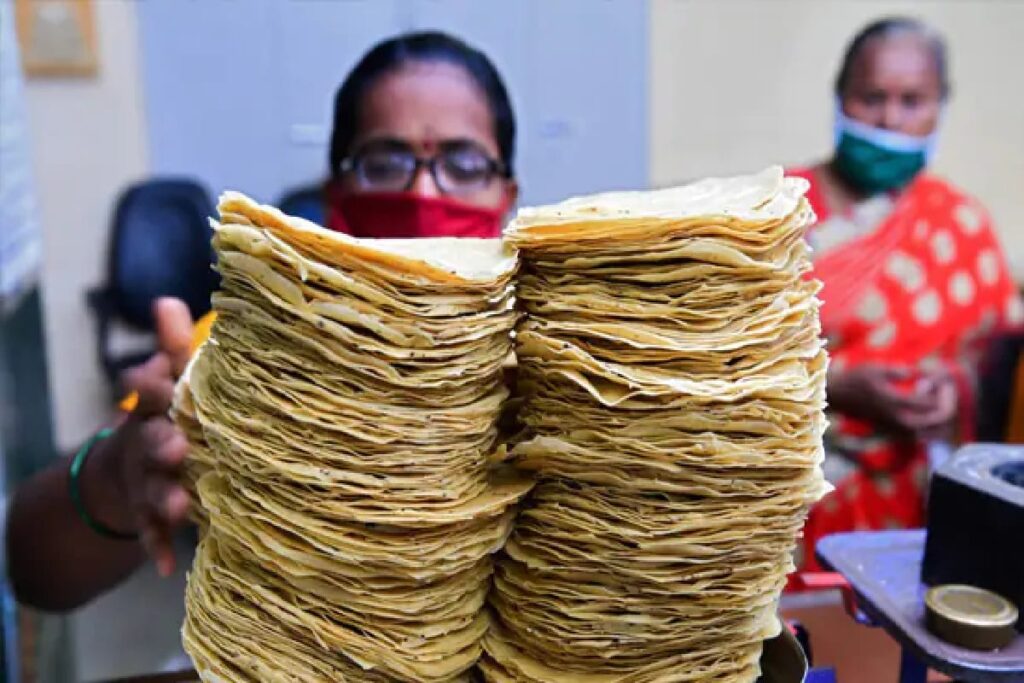Papad is a thin wafer-like very tasty and popular food product. Any individual can initiate papad making business as small-scale, home-based basis or in a large scale. It sometimes described as a cracker or flatbread. Papad can be cooked by deep-frying, roasting over an open flame, toasting or microwaving, depending on the desired texture. Papad making is considered as a very lucrative and profitable food manufacturing opportunity, considering the low-cost capital investment.
Demand for different varieties of papad is increasing steadily. The demand is steady throughout the year and it generally hikes 10-155% during the festive season. In the Indian context, there is some national brand, but the market is predominantly controlled by local manufacturers. In initiating papad making business, it is advisable to make a prior market research about the preferred tastes of local consumers.
Papad Making License & Permissions
Register your business with ROC according to your firm’s ownership pattern. For a small scale unit, it is advisable to register as an OPC company. You may also register your unit as SSI. Apply for Vat Registration. Compliance with PFA Act is mandatory for papad making. Quality standards as specified by BIS are available to vide IS 2639:1984
FINANCE FOR PAPAD MAKING
Alike any manufacturing business two types of funding is required in starting papad making business. The fixed capital which can be procured as term loan and working capital that can be raised via cash credit or overdraft facility. With a detailed project report with financial calculation, you can apply to a bank or to any financial institutions like microfinance or cooperatives. You can also approach any angel investor to arrange the startup capital.
MACHINERY & RAW MATERIALS FOR PAPAD MAKING
Papad making unit can be established by three ways, such as manual, semi-automatic and automatic. CFTRI, Mysore, has successfully developed papad press. Various different types of pedal-operated papad press machines are available. To get small quantity output you can use this type of machine.
SEMI AUTOMATIC PAPAD MAKING UNIT
You can establish a semi-automatic papad making unit also to get more production output than a manual system. In this case you will need to have an electric grinding machine, mixing machine, electric papad press machine, drying machine with trolley, water storage tank, weighing scale, pouch sealing machine and some laboratory equipment.
FULLY AUTOMATIC PAPAD MAKING UNIT
To get large scale production output, you can establish fully automatic papad making machine. These machines are used by the industry for churning out large volumes of papad at one go. The entire process is looked upon by the machine from mixing of ingredients to collection of ready-to-deliver Papad. These machines being durable, sturdy and high performing.
The major raw materials are pulses and rice flour. Salt and peanut oils are added to the flour to make a dough, which can be flavored with chili, cumin, garlic or black pepper. Sometimes baking soda and preservatives are also added. According to the desired taste, several different ingredients are used like moong dal, udad dal etc. The shelf life of papad is generally three month. A moisture proof packaging is important.
Some popular variety of papad is masala papad, Punjabi masala papad, Bikaner masala papad, aam papad, moong special papad, shrimp papad etc. According to the desired taste and quality, you will need to select the right recipe.
PAPAD MAKING PROCESS
 Papad can be manufactured from different varieties of pulses or there could be a combination of pulses as well. Adequate quantity of water is added in flour of pulses, common salt, spicesand sodium bicarbonate and homogenous mixing is done to obtain a dough. After about 30 minutes, small balls weighing around 7-8 grams of dough are made. These balls are then placed in papad making machine or papad press wherein these balls are pressed and circular papads are made as per the size of the mould. These papads are then sun-dried but in this note drier with trolley is recommended as sun-drying may not be always feasible in Assam. A lot of 25 or 50 papads is then packed in polyethene bags. In automatic papad making machine, as we discussed earlier, the entire process is done by that single machine with minimum labour inputs.
Papad can be manufactured from different varieties of pulses or there could be a combination of pulses as well. Adequate quantity of water is added in flour of pulses, common salt, spicesand sodium bicarbonate and homogenous mixing is done to obtain a dough. After about 30 minutes, small balls weighing around 7-8 grams of dough are made. These balls are then placed in papad making machine or papad press wherein these balls are pressed and circular papads are made as per the size of the mould. These papads are then sun-dried but in this note drier with trolley is recommended as sun-drying may not be always feasible in Assam. A lot of 25 or 50 papads is then packed in polyethene bags. In automatic papad making machine, as we discussed earlier, the entire process is done by that single machine with minimum labour inputs.


